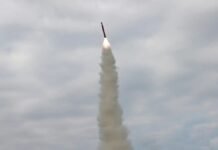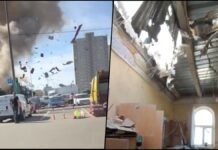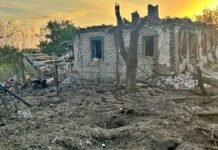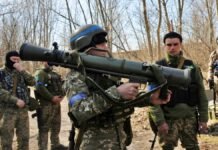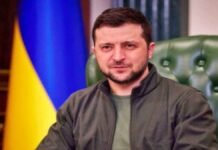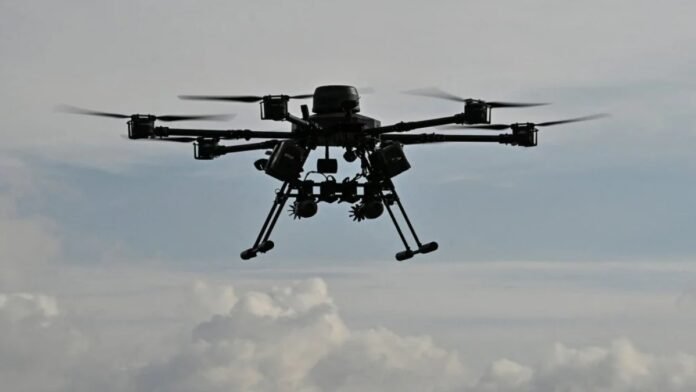
Key Points:
- Ukraine launched its largest coordinated drone offensive against Russian territory on October 26-27, 2025, with Russian authorities claiming to have intercepted 193 drones across 13 regions, including 34 specifically targeting Moscow over a sustained five-hour assault beginning at 10 p.m. local time on Sunday.
- Moscow’s Domodedovo Airport, the largest commercial hub serving the capital, and Zhukovsky Airport were forced to suspend operations for approximately 2.5 hours starting at 2240 GMT to ensure air safety amid the unprecedented drone barrage—marking a significant disruption to civilian aviation infrastructure.
- Despite Russian claims of complete interception success, multiple explosions were reported across Moscow districts including Kommunarka, Podolsk, and Kolomna, with a fire erupting at an oil depot in Serpukhov, Moscow Oblast, and widespread panic spreading through local social media channels as smoke plumes rose over the city.
- The assault represents a dramatic escalation in Ukraine’s deep-strike campaign targeting Russian military infrastructure, energy facilities, and strategic assets, coming just days after President Volodymyr Zelensky reported that Russia had launched nearly 1,200 attack drones and 50 missiles against Ukraine in the previous week alone, killing five people in recent Kyiv attacks.
- Ukrainian authorities have maintained official silence on the operation, consistent with their policy of not claiming responsibility for strikes inside Russian territory, though the attack aligns with Kyiv’s stated strategy of degrading Russia’s war-sustaining infrastructure including oil refineries, weapons factories, and ammunition depots located deep within enemy territory.
New Delhi: Ukraine launched its most ambitious and extensive drone offensive against Moscow and surrounding Russian regions in the early hours of Monday, October 27, 2025, deploying what Russian authorities described as a massive coordinated assault involving 193 unmanned aerial vehicles across 13 regions, including 34 drones specifically targeting the capital itself. The unprecedented barrage forced the temporary closure of two major Moscow airports, triggered widespread explosions and fires across the metropolitan area, and exposed significant vulnerabilities in Russian air defense systems despite official claims of complete interception success.
The assault marks a dramatic escalation in Ukraine’s deep-strike campaign against Russian territory, demonstrating Kyiv’s growing capability and willingness to project force hundreds of kilometers beyond the front lines to strike at the heart of Russian political and economic power. As the conflict enters its fourth year, the sophisticated multi-wave attack underscores the increasingly critical role of unmanned aerial warfare in the Russia-Ukraine conflict.
Five-Hour Aerial Battle Over Moscow
The drone offensive against Moscow commenced just before 10 p.m. Moscow time (1900 GMT) on Sunday evening, October 26, and continued in successive waves for approximately five hours into the early morning hours of Monday, according to Mayor Sergey Sobyanin’s real-time updates posted on the Telegram messaging platform throughout the night. Russian air defense units reportedly engaged and destroyed 28 to 34 Ukrainian drones approaching or flying over the capital during this sustained period of aerial combat.
The Russian Defense Ministry subsequently issued a comprehensive statement claiming that a total of 193 Ukrainian drones had been intercepted and destroyed overnight across 13 different regions, with 40 drones downed over Moscow Oblast (the broader region surrounding the capital), of which 34 were specifically bound for Moscow city itself. An additional 24 drones were reportedly destroyed in the neighboring Tula region, which borders Moscow to the south, suggesting a coordinated multi-pronged Ukrainian operation designed to overwhelm Russian air defenses through simultaneous attacks across multiple vectors.
Military analysts noted that the scale and coordination of the assault represented a significant operational achievement for Ukrainian forces, requiring sophisticated planning, logistics, and intelligence to launch nearly 200 drones simultaneously or in rapid succession while maintaining targeting discipline across such an expansive geographic area.
Airport Closures Disrupt Aviation
In response to the drone threat, Russian aviation watchdog Rosaviatsiya ordered the immediate closure of Domodedovo Airport—Moscow’s largest commercial aviation hub and Zhukovsky Airport, a smaller facility located southeast of the capital that serves both civilian and cargo operations. The shutdown commenced at 2240 GMT (1:40 a.m. Moscow time) on Monday morning and lasted approximately 2.5 hours to “ensure air safety” as air defense systems engaged the incoming drone swarm.
The airport closures represented a significant disruption to civilian aviation infrastructure and Moscow’s transportation networks, affecting potentially dozens of scheduled flights and thousands of passengers during the nighttime hours. While Domodedovo and Zhukovsky were shuttered, Moscow’s two other major airports, Sheremetyevo and Vnukovo,o apparently continued operations, though flight paths may have been adjusted to avoid active air defense zones.
This marked the second time in recent weeks that Ukrainian drone attacks have forced Moscow airport closures, highlighting the recurring impact of Ukraine’s deep-strike campaign on civilian infrastructure and the Russian capital’s vulnerability to aerial assault despite layers of sophisticated air defense systems deployed to protect the city.
Explosions, Fires, and Panic Across Moscow
Despite official Russian claims of complete interception success, multiple explosions were reported across various Moscow districts and surrounding areas throughout the night, accompanied by visible smoke plumes, fires, and widespread panic among residents documented through social media posts and Russian Telegram channels. Explosions were specifically confirmed in the Kommunarka district within Moscow city limits, as well as the surrounding towns of Podolsk, Kolomna, and Serpukhov in Moscow Oblast.
A fire erupted at an oil depot in Serpukhov, approximately 100 kilometers south of Moscow, on Sunday evening, according to the Russian Telegram news channel Astra, citing eyewitness footage and reports. While local administration officials declined to officially confirm the cause of the blaze and claimed it had been quickly extinguished, the timing and location strongly suggested a connection to the Ukrainian drone assault.
Photographs and videos circulated widely on Russian social media platforms showed dramatic scenes of smoke rising over the Moscow skyline, emergency vehicles responding to multiple locations, and what appeared to be debris from downed drones or interceptor missiles scattered across residential areas. Russian Telegram channels also shared images of Russian military personnel manning improvised air defense positions, soldiers in pickup trucks equipped with machine guns positioned directly opposite the Kremlin, suggesting authorities had deployed ground-based fire teams to supplement electronic air defense systems.
Mayor Sobyanin confirmed that emergency services had been dispatched to all reported crash sites but provided minimal details about casualties or damage, consistent with Russian authorities’ typical policy of minimizing disclosure of impacts from Ukrainian strikes unless civilian casualties or infrastructure damage cannot be concealed.
Pattern of Escalating Drone Warfare
The October 26-27 assault represents the latest and most ambitious installment in Ukraine’s systematic campaign of long-range drone strikes targeting Russian military infrastructure, energy facilities, and strategic assets deep within Russian territory. Ukraine has consistently used domestically-produced long-range unmanned aerial vehicles to attack oil refineries, weapons manufacturing plants, ammunition storage depots, military airfields, and command-and-control facilities located hundreds of kilometers from the front lines.
According to previous reports, Ukraine allegedly targeted Moscow with 34 drones in an overnight strike on September 22, 2025, indicating a pattern of escalating attacks against the Russian capital with increasing frequency and scale. Just days before the October 26-27 assault, on October 23-24, Ukrainian drones struck multiple Russian regions in what was then described as a major barrage, with 144 drones intercepted according to Russian claims, resulting in at least five injuries when one drone hit a 14th-floor apartment in Krasnogorsk, northwest of Moscow.
The intensifying Ukrainian drone campaign targeting Moscow and other Russian cities occurs within the context of Russia’s own relentless aerial assault on Ukrainian population centers. President Volodymyr Zelensky stated on October 26 that Russia had attacked Ukraine with nearly 1,200 strike drones and more than 50 missiles—primarily ballistic missiles—in just the past week alone. Recent Russian drone and missile strikes on Kyiv have killed at least five people and injured dozens more over consecutive nights, with Russia attempting “to inflict as much damage as possible on ordinary life,” according to Zelensky.
Ukrainian Strategic Objectives and Official Silence
Ukrainian authorities maintained their customary official silence regarding the October 26-27 Moscow assault, declining to claim responsibility or provide operational details a consistent policy approach for strikes conducted inside Russian territory. However, Kyiv has previously articulated that its long-range strike operations focus on “incapacitating Russia’s infrastructure that is vital for sustaining Moscow’s military efforts in Ukraine,” including energy production and distribution systems that power Russian military industries, logistics networks supporting force deployment, and manufacturing facilities producing weapons and ammunition.
Ukrainian military commanders and officials have emphasized that targeting Russian oil refineries, fuel depots, and energy infrastructure directly undermines Russia’s ability to sustain military operations by disrupting fuel supplies for vehicles, aircraft, and ships, while also inflicting economic costs that strain Russia’s capacity to finance the war. Similarly, strikes on weapons factories, ammunition storage sites, and military airfields aim to degrade Russia’s offensive capabilities by destroying matériel before it can reach the battlefield.
A senior Ukrainian drone warfare commander told Reuters on October 24 that Ukraine is engaged in a continuous technological race to “outfox Russian defenses” as Moscow improves its electronic warfare capabilities, jamming systems, and interception techniques. The commander indicated that Ukrainian forces are constantly developing new drone models with enhanced range, payload capacity, stealth characteristics, and resistance to electronic countermeasures to maintain effectiveness against evolving Russian air defense systems.
The October 26-27 assault’s scale and coordination, deploying nearly 200 drones simultaneously across multiple regions, suggests a deliberate Ukrainian strategy to overwhelm Russian air defense networks through saturation attacks, forcing defenders to prioritize targets and potentially allowing some drones to penetrate to their objectives while defenses are occupied with intercepting others.
Russian Air Defense Claims and Credibility Questions
Russian authorities asserted that their air defense systems successfully intercepted and destroyed all 193 Ukrainian drones launched in the overnight assault, preventing any from reaching their intended targets. However, the widespread reports of explosions, fires, particularly at the Serpukhov oil depot, visible smoke plumes over Moscow, and emergency service deployments to “all crash sites” raise significant questions about the completeness and accuracy of these official claims.
Military analysts note that Russia’s pattern of claiming total interception success while simultaneously acknowledging explosions, fires, and “crash sites” requiring emergency response suggests a more complex reality in which some drones likely evaded interception or achieved their targeting objectives. Additionally, Russian air defense interceptor missiles and debris from downed drones can themselves cause significant damage when they fall in populated areas a recurring problem that Russian authorities typically attribute to “falling debris” rather than acknowledging successful Ukrainian strikes.
The fact that Russian officials deployed ground-based fire teams with machine guns in central Moscow, including positions near the Kremlin, indicates concerns about drones penetrating sophisticated electronic air defense systems and the need for last-resort kinetic interception capabilities. This development suggests potential vulnerabilities in Russia’s layered air defense architecture when confronting large-scale saturation attacks using relatively small, low-flying, and difficult-to-detect unmanned aerial vehicles.
Russia’s stated policy of rarely disclosing the full scale of damages inflicted by Ukrainian strikes inside its territory “unless civilian objects are involved” creates significant information gaps and credibility challenges for official claims, as independent verification of military or industrial facility damage is virtually impossible given Russian information controls.
Broader Strategic Implications
The October 26-27 drone offensive against Moscow and surrounding regions represents a watershed moment in the Russia-Ukraine conflict’s evolution, demonstrating Ukraine’s growing capacity to project sustained, large-scale conventional force deep into Russian territory despite Moscow’s numerical and technological advantages. The assault’s psychological and political impact on Russian society—bringing war directly to the capital’s doorstep, disrupting civilian aviation, and generating visible explosions and fires—may prove as significant as its military effects on targeted infrastructure.
For Ukraine, the ability to strike Moscow with increasing frequency and scale serves multiple strategic objectives: degrading Russia’s war-supporting infrastructure, imposing economic costs, demonstrating to domestic and international audiences that Russia is not immune to conventional attack, and potentially influencing Russian public opinion about the costs of continuing the war. The attacks also compel Russia to divert substantial air defense resources to protect rear-area facilities and population centers, potentially weakening defenses along the front lines.
However, the escalating exchange of drone and missile strikes on both nations’ cities and infrastructure carries significant risks of further escalation, civilian casualties, and increasing devastation to critical infrastructure on both sides. Russia’s massive retaliatory strikes against Ukrainian cities following Ukrainian attacks on Russian territory have killed civilians and destroyed residential buildings, demonstrating the deadly cycle of escalation that long-range strike campaigns can generate.
As the conflict approaches the end of its third year and enters what many analysts expect to be a decisive fourth year, the intensifying drone warfare with Ukraine launching its largest-ever Moscow assault and Russia responding with equally massive strikes on Kyiv and other Ukrainian cities suggests that both sides view long-range strike campaigns as critical components of their overall strategies, despite the humanitarian costs and infrastructure destruction they produce.




